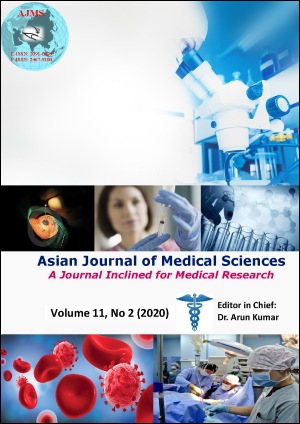Drug Interaction analysis-Nigella sativa L.seed (Black Cumin) ethanolicextract on antiseizure activity of Phenobarbitone sodium
Keywords:
Nigella Sativa, Maximal electroshock seizures, Epilepsy, Phenobarbitone, EthnopharmacovigilanceAbstract
Background: Multidisciplinary therapy is gaining popularity and drug herb interactions is one of the biggest risk factor contributing to therapeutic failures or toxicities. Apart from analysis of one of such Drug-Herb combinations, this work also aims at emphasizing need for ethnopharmacovigilance practices.
Aims and Objectives: Herb-Drug Interaction analysis between Nigella sativa seed ethanolic extract and Phenobarbitone sodium in maximal electroshock seizure in Swiss albino mice with a modified isobolographic analysis.
Materials and Methods: Experiment model was Maximal electroshock seizure in Swiss albino mice. Dose ratios of the combination tested were NsEE: Phenobarbitone; 3:1(NsEE75%: Pbt25%), 1:1, 1:3. Analysis was done with modified isobolographic analysis.
Results: Nigella sativa seed ethanolic extract exhibit synergistic interaction with Phenobarbitone sodium at 1:1 and 1:3 dose ratios and antagonistic interaction at 3:1 combination. The parameter measured was Hind limb tonic extensor phase in maximal electroshock seizure test in Swiss albino mice.
Conclusion: The study showed that interaction profile of Nigella sativa extract-phenobarbitone combination is dose dependent and requires well designed posological studies in epileptic patients to formulate dose adjustment guidelines for multidisciplinary therapy with the herb and Phenobarbitone, also to avoid food drug interactions.
Downloads
Downloads
Published
How to Cite
Issue
Section
License
Authors who publish with this journal agree to the following terms:
- The journal holds copyright and publishes the work under a Creative Commons CC-BY-NC license that permits use, distribution and reprduction in any medium, provided the original work is properly cited and is not used for commercial purposes. The journal should be recognised as the original publisher of this work.
- Authors are able to enter into separate, additional contractual arrangements for the non-exclusive distribution of the journal's published version of the work (e.g., post it to an institutional repository or publish it in a book), with an acknowledgement of its initial publication in this journal.
- Authors are permitted and encouraged to post their work online (e.g., in institutional repositories or on their website) prior to and during the submission process, as it can lead to productive exchanges, as well as earlier and greater citation of published work (See The Effect of Open Access).




